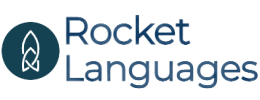Despite not having the name recognition of Pimsleur or Duolingo, Rocket Spanish has a cult-like following among its users, with people swearing by it. And after using this program, I can see why. With in-depth audio lessons, smart grammar teaching points, and fun supplemental drills, it definitely impressed. But it’s not without its issues. Read on for our full review.
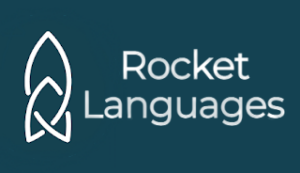
Rocket Spanish
- 14-Day Money Back Guarantee
- Free Trial
Pros
- Interactive audio lessons quickly develop your speaking and listening comprehension skills
- Leverages Google’s web speech API for voice software
- Smart way of teaching grammar in Language & Culture lessons
- New interface is fast and beautiful
Cons
- Lessons are lengthy and drag a little at times
- Not many pictures or visuals in program
Video: Is Rocket Languages Good For Learning Spanish?
In the video above, Bianca from the Guide2Fluency team discusses the pros and cons of learning Spanish using Rocket Languages.
How Rocket Spanish Works
To begin this review, I want to break down how Rocket Spanish works from a high level. This will help to provide some context for my thoughts on this program in terms of pros and cons, which I’ll address below.
Starting at the top, the Rocket Spanish course is broken down into three levels—beginner, intermediate and advanced. Within each overarching level, there are a number of modules you need to complete.
Then within each module, there are a number of lessons to complete. All in all, there are about a dozen lessons per module—sometimes more, sometimes fewer. It just depends.
Regardless, the interesting thing about Rocket Spanish, and what separates them from other language learning apps, is that they have two different types of lessons.

Most other Spanish apps have just one type of lesson, but Rocket actually bifurcates their content. About half the lessons in each module are “interactive audio” lessons, while the rest are “language & culture” lessons. It’s pretty interesting.
The interactive audio lessons are definitely the bigger and more important lessons, and are generally the backbone of the Rocket Spanish program.
Each interactive audio lesson kicks off with a 30-minute audio exercise, where a moderator speaking in English guides you through a lesson based around a mock conversation.
The conversation will feature two fluent Spanish speakers having a discussion, and the moderator will pause to explain what you’re hearing, define phrases, have you repeat certain parts, and ask you questions. It’s essentially an interactive, guided conversation.
Then following each audio lesson, you complete a series of supplemental drills and exercises. These include flashcards, listen-and-repeat drills, reading and writing drills, and quizzes.
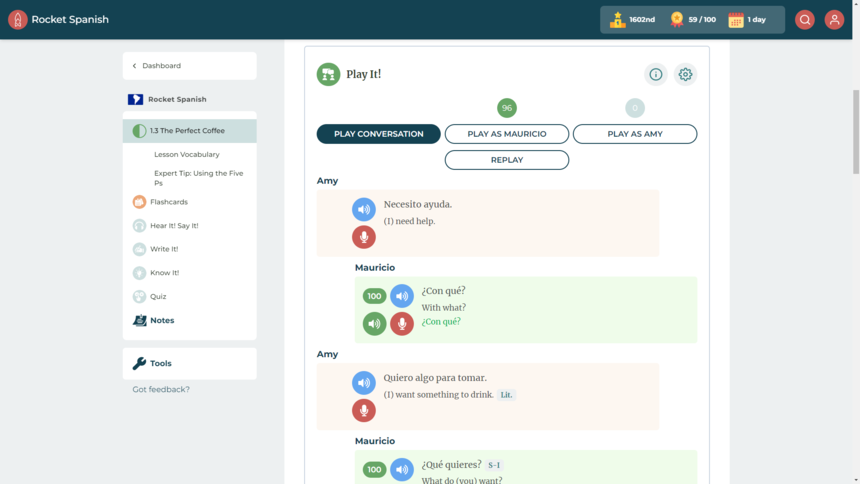
Altogether, the audio exercise plus all the supplemental drills makes each interactive audio lesson about an hour long from end-to-end.
Then the other type of lesson you will work on, the “language & culture” lessons, dive deeper into key grammar points. These lessons explain grammar principles from the audio portion, and use examples, images and mini-drills to demonstrate important points.
Plus, they kick in some cool cultural stuff you should know about Latin America if you will be traveling or living there.
From a 10,000-foot view, that’s about it for the Rocket Spanish program. Around these main lessons, there are some bonus tools and features, like language survival kits, a streak tracker, forums, and leaderboards, but those are mostly ancillary to the main lesson work.
Rocket Spanish Cost
Before we dive straight into the major pros and cons of Rocket Spanish, let’s quickly discuss cost and how they compare to other apps.
To begin, Rocket does things a little differently from most other language learning apps. Most apps these days use a subscription model, where you pay a small monthly fee as you go—usually $8 to $20 per month.
Rocket, however, doesn’t do the subscription model. They instead only sell one-time purchase, lifetime plans. You buy the course and get access forever.

Because of this though, the plans are a little pricier than most other Spanish programs. The Level 1 Beginner bundle is $150, the Level 2 Intermediate bundle is $300, and the Level 3 bundle, which will take you all the way up to advanced, is $450.
Thus, Rocket is more expensive than other options like Duolingo, Babbel and Rosetta Stone. However, one thing I’ll note is that Rocket is really aggressive with their deals and special promotions, and you can almost always find a steep discount on their programs, so do make sure to check for coupon codes.
In my experience, you can almost always find a code to save yourself 50% to 60% off full retail, making the Rocket Spanish all-in price much more reasonable.
Rocket Spanish: The Positives
Now that you know how Rocket Spanish works and what it costs, let’s get into my thoughts on this program—the pros and cons.
Let’s start with the positives, as I think there’s more good news here than bad.
Rocket’s Secret Sauce: Audio Lessons
The clearest highlight of Rocket Spanish by far is their interactive audio lessons. These audio lessons are really the heart and soul of this program, and what makes Rocket different from most other language apps (apart from maybe Pimsleur).
These audio lessons are really engaging and do a great job of getting you to actually think under pressure and verbalize what you’re learning.
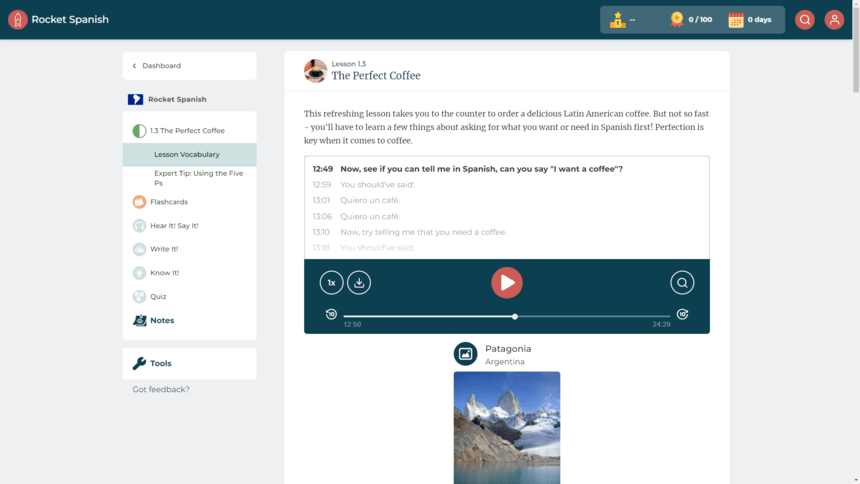
What you’ll notice with a lot of other language apps like Duolingo and Rosetta Stone is that they don’t have large doses of listening or speaking exercises.
However, that’s literally 75% of the Rocket Spanish program. And to me, hearing heavy doses of Spanish on a near daily basis is the most powerful way of internalizing the language and becoming comfortable with it. You just have to listen to and speak a lot of Spanish to get faster and more fluent.
Plus, one of the really nice features of the Rocket audio lessons is that when you’re done with the audio lesson, you can then play the underlying conversation that the lesson is built around in real time, and play the part of one of the two actors.
In-Depth Grammar
My second pro for Rocket Spanish is how they teach grammar in the “language & culture” lessons.
Stepping back, it needs to be noted that Spanish apps take some pretty different approaches to teaching grammar.
Some, like Rosetta Stone and Pimsleur, teach hardly any grammar at all, instead allowing you to pick it up more intuitively as you work lessons. Then, there are others like Babbel and Busuu, which layer in shorter, punchier grammar points directly into the lessons every few slides or drills.
Rocket takes a more direct approach though, and has full grammar lessons supplementing the primary audio lessons.
The nice thing, however, is that they don’t clobber you with over-analysis in these lessons. It is usually just a quick 2-3 sentence explainer, followed by some examples.
Rocket will do that for a handful of teaching points in each lesson, which I really like.
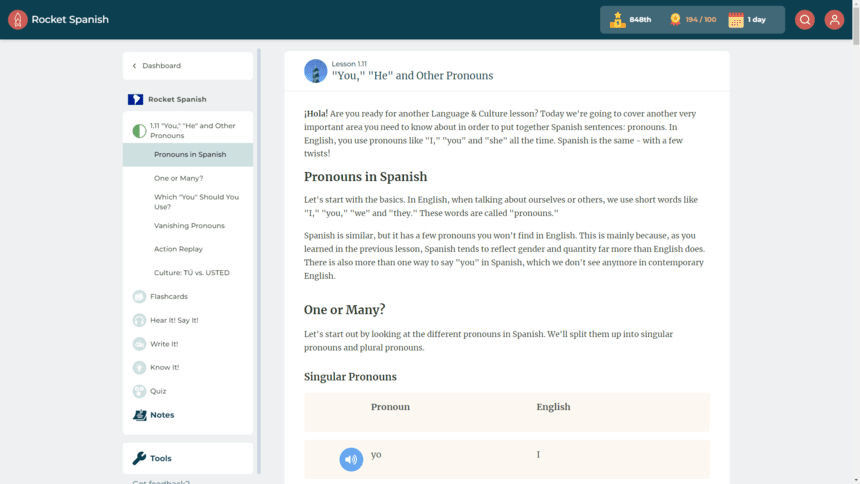
Not to mention, they sprinkle in some cool cultural things about etiquette and other norms as well, which is pretty cool if you’re planning on traveling in Latin America or moving there.
Accurate Speech Recognition Software
Another pro for Rocket Spanish is their speech recognition software. As you work any drill that has a speaking component, Rocket’s tech listens in and gives you feedback on your pronunciation on a scale of 1 to 100.
They use Google’s web speech API for their underlying software, and it is really strong.
Other apps I’ve reviewed have speech software that’s a little laggy and inconsistent, but Rocket’s is very accurate. Therefore, if pronunciation feedback is important to you, give Rocket a good, long look.
Beautiful New Interface
Lastly, my final win Rocket is their new interface. The facelift they have given their program in the last or two is awesome.
The old interface was so outdated that despite the program being effective and having great content, it just had this sort of cheap feel to it.
The new look and feel of the program, however, is awesome. These changes have really brought it in line with other Spanish programs like Pimsleur and Rosetta Stone.
Rocket Spanish: The Negatives
So those are the things I really like about Rocket Spanish. Now, let’s switch over to the things I don’t necessarily like.
Lessons Can Feel Long
The first downside of the Rocket Spanish program is the lesson length. As noted above, to complete a full Rocket audio lesson from end-to-end, it’s about an hour. Again, that’s considering the audio portion plus all the supplemental drills and quizzes.
To be clear, the “language & culture” lessons are shorter (those take just 15 to 20 minutes), but the primary audio lessons are pretty lengthy.

I have to admit that at around the 20-minute mark of each main audio exercise, my mind would start to wander a little.
I did end up breaking the audio lessons into sections across back-to-back days to help with that, but nonetheless, they are a little long.
No Pictures For Visual Learners
My second negative is that there isn’t much imagery in the Rocket Spanish program. Other apps, like Lingopie, Memrise and Rosetta Stone, are big on pictures and imagery, but Rocket is definitely not a graphic-heavy program.
Rocket Spanish more so relies on audio and text. So for visual learners, this could be an issue. If you’re a very visual person, keep this in mind. Rocket might not be the ideal fit.
No Driving Mode
Lastly, my final downside is that there is no driving mode. The Rocket lessons all use a rolling transcript with the main audio portion, so you can see who is speaking and how words are spelled.
This gives you a nice chance to follow along and does make the audio lessons more engaging, but it also makes these lessons tougher to do on the road because you become hooked on the transcript.
By contrast, Rocket’s closest competitor in the language learning space, Pimsleur (which also leans heavily on audio lessons), offers a special driving mode that allows you to do lessons on your commute with no transcript, as well as offering some hand-free features.
I personally think it would be cool to see Rocket Spanish add something like this, as using downtime on the road to do lessons would be a huge bonus.
Verdict: Is Rocket Spanish Worth It?
Overall, I won’t lie, I really like Rocket Spanish. Of the dozen or so apps I’ve used and tested, it’s one of my favorites. In my opinion, it’s better than Duolingo, Rosetta Stone and a bunch of other big name companies.
It does have some issues with the audio lessons being a little long, and there not being many graphics or visuals in the program, but overall, it’s one of the deepest, most comprehensive Spanish programs I’ve seen.
I think if you’re truly serious about becoming fluent at intermediate to advanced level, Rocket will get you there, and a lot faster than most of the other apps I’ve reviewed.
Yes, after testing and reviewing this program, Rocket Spanish is one of the better and more effective apps I’ve used. The interactive audio lessons are a real difference maker and I found them to be powerful for getting me talking.
Rocket Spanish is sold in three levels. Though not labeled as such, they are sort of a beginner, intermediate and advanced set. They cost $150, $300, and $450, respectively. However, they can almost always be found for 50% or more off.
What separates Rocket Languages from other Spanish programs is their use of interactive audio lessons. These audio lessons are 30 minutes long each and get you immediate exposure to the language.

